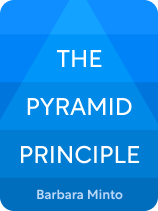

This article is an excerpt from the Shortform book guide to "The Pyramid Principle" by Barbara Minto. Shortform has the world's best summaries and analyses of books you should be reading.
Like this article? Sign up for a free trial here.
What is The Pyramid Principle by Barbara Minto about? What are the main takeaways of the book?
In The Pyramid Principle, Barbara Minto claims she has a new approach to writing that will make your prose clear and understandable. In her book, you’ll learn how to plan out your ideas before you begin writing, and how to write a stellar conclusion.
Read below for an overview of Barbara Minto’s book The Pyramid Principle.
The Pyramid Principle by Barbara Minto
What if you could write so clearly that your reader could perfectly understand your main ideas within the first 30 seconds of reading your prose? In The Pyramid Principle, Barbara Minto claims this is possible. She argues that the secret to clear, effective writing is beginning with your conclusions. She envisions strong writing to be structured like a pyramid, with conclusions at the peak and supporting evidence branching out beneath.
Minto developed this writing approach while working for a management consulting firm. She noticed that many of her colleagues were producing unclear reports that failed to reflect the strength of their ideas. She discovered that their writing was unclear because their ideas weren’t logically organized. Workers around the world now use her method to improve the organization of their reports. However, Minto’s approach works for any type of nonfiction writing. You can use it to improve how you write everything from emails to essays.
The Problem: Unclear Writing
According to Minto, people often produce unclear writing that’s time-consuming and mentally taxing to read. Minto begins this section by exploring people’s typical writing process. Then, she examines people’s typical reading process. Finally, she contrasts these two processes to illustrate why our typical writing approach fails to meet readers’ needs.
The Solution: Pyramid Writing
According to Minto, Pyramid Writing solves the problem of unclear writing by ensuring that you express your conclusions first. She begins this section by explaining the main elements of the pyramid that gives this approach its name. Next, she describes what it’s like to read Pyramid writing. Finally, she explores what it’s like to write it.
The Elements of the Conclusions-First Pyramid
Let’s explore Minto’s pyramid structure, which we’ll call the Conclusions-First Pyramid. Here, we’ll visualize this pyramid and explain each of its labeled elements:
- The Peak: The top of the pyramid, which we call the Peak, represents the beginning of your written piece. This is where you present your piece’s main conclusion, which we’ll call the Peak Conclusion.
- Tier 1: After your Peak Conclusion comes the ideas it summarizes—the ideas that support it. These supporting ideas are the “bricks” that hold up the Peak Conclusion. We’ll call the row these supporting ideas occupy Tier 1.
Stage 1: Brainstorm
In this section, Minto describes two steps for brainstorming your ideas: clarifying your topic and filling out the Conclusions-First Pyramid.
Step 1: Clarify Your Purpose
According to Minto, before you fill out your pyramid, you must clarify your purpose: what you want your piece to teach your readers. Minto claims that all readers are motivated to read so that they learn something new. To ensure you’ll fulfill this motivation, brainstorm answers to these two questions:
Question 1: What main question would your readers have about your topic? For example, if your topic is your city’s new composting program, your neighbors might wonder, “Should I compost?”
(Shortform note: Before determining your question, it may be helpful to pinpoint who your audience is and why they’re reading your piece. Briar Goldberg, the director of speaker coaching at TED, argues that public speakers should try to align their message with their audience’s goals. This makes it more likely that they’ll find your speech useful and memorable. You can apply this same idea to your writing, as well. While brainstorming your question, follow this advice from Goldberg: Consider who your audience is, why they’re taking time to pay attention to your ideas, and what they’ll likely want to gain from your ideas.)
Question 2: What’s your answer to your reader’s question? This answer will be your Peak Conclusion. For instance, your answer to the question “Should I compost?” might be “You should compost.” However, Minto points out that you may not always know your answer this early in the brainstorming process. In this case, skip brainstorming your answer—you’ll formulate it in the next step.
Step 2: Fill Out the Conclusions-First Pyramid
After you clarify your purpose, your next step is to use the Conclusions-First Pyramid to structure your ideas. According to Minto, there are two approaches to filling out the pyramid: a peak-to-base approach and a base-to-peak approach. The first approach has you fill out the pyramid from the top down. Minto recommends using the peak-to-base approach if you’ve already formulated an answer (the Peak Conclusion). By contrast, the base-to-peak approach has you fill out the pyramid from the bottom up. Use this approach if you haven’t yet brainstormed a Peak Conclusion or if the peak-to-base approach didn’t work for you.
Stage 2: Write
After you’ve brainstormed your ideas in a pyramid structure, the next stage of Pyramid Writing is converting those ideas into prose. In this section, Minto shares four goals for doing so. We call these “goals” rather than “steps” to emphasize that you can accomplish them in any order.
- Write a clear, engaging introduction
- Order ideas logically
- Make your organization clear to your reader
- Craft a motivating conclusion

———End of Preview———
Like what you just read? Read the rest of the world's best book summary and analysis of Barbara Minto's "The Pyramid Principle" at Shortform.
Here's what you'll find in our full The Pyramid Principle summary:
- How to write so clearly that you can get a point across within 30 seconds
- How to write a clear, compelling introduction, body, and conclusion
- Why you should always start your prose with your conclusion and work backward






